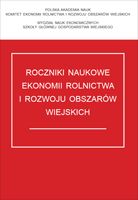Main Article Content
Article Details
Bednarski L. 2002: Analiza finansowa w przedsiębiorstwie. PWE, Warszawa, s. 1-209.
Cieślik J. 2005: Stan i kierunki rozwoju sektora mleczarskiego w regionie małopolskim. [W:] Agrobiznes 2005. Zmiany w agrobiznesie po przystąpieniu Polski do Unii Europejskiej. Prace Naukowe AE we Wrocławiu nr 1070, tom I, Wrocław, s. 97-101.
Folga J. 2006: Odmrażanie gotówki. Magazyn Finansistów nr 3, s. 17-19.
Iwan B. 2005: Zmiany w mleczarskiej bazie surowcowej po przystąpieniu Polski do Unii Europejskiej. [W:] Agrobiznes 2005. Zmiany w agrobiznesie po przystąpieniu Polski do Unii Europejskiej. Prace Naukowe AE we Wrocławiu nr 1070, tom I, Wrocław, s. 342-347.
Kallberg J., Parkinson K. 1993: Corporate Liquidity. Management and Measurement. Irwin, Homewood, s. 1-603.
Narkiewicz J. 2004: Identyfikacja ryzyka utraty płynności finansowej w raporcie rocznym przedsiębiorstwa. Prace Naukowe Katedry Ekonomii i Zarządzania Przedsiębiorstwem, tom III, Politechnika Gdańska, Gdańsk, s. 129-142.
Sierpińska M., Wędzki D. 1997: Zarządzanie płynnością finansową w przedsiębiorstwie. PWN, Warszawa.
Wasilewski M., Kowalczyk A. 2004: A comparative analysis of dairy cooperatives according to quality of management and production. Electronic Journal of Polish Agricultural Universities, Economics, Volume 7, Issue 2, s. 1-10.
Wędzki D. 2003: Strategie płynności finansowej przedsiębiorstwa. Przepływy pieniężne a wartość dla przedsiębiorstwa. Wydawnictwo Oficyna Ekonomiczna, Kraków.
Wyrzykowska B. 2000: Procesy dostosowawcze w branży mleczarskiej do warunków gospodarki rynkowej. Zeszyty Naukowe SGGW, Ekonomika i Organizacja Gospodarki Żywnościowej, (39), 115-124.
Downloads
- Ewa Kołoszycz, The profitability of the milk production in Polish dairy farms in 2004. members of the European Dairy Farmers , Annals of Agricultural Economics and Rural Development: Vol. 93 No. 1 (2006)
You may also start an advanced similarity search for this article.
- Mirosław Wasilewski, Kinga Gruziel, The value added tax in the opinion of private farmers , Annals of Agricultural Economics and Rural Development: Vol. 93 No. 1 (2006)
- Mirosław Wasilewski, Equity versus economic results of agricultural enterprises , Annals of Agricultural Economics and Rural Development: Vol. 92 No. 2 (2006)
- Marzena Chmielewska, Dependences between sales profits and cost in dairy cooperatives , Annals of Agricultural Economics and Rural Development: Vol. 96 No. 3 (2009)
- Anna Wasilewska, Mirosław Wasilewski, Costs and labour productivity in agricultural enterprises , Annals of Agricultural Economics and Rural Development: Vol. 94 No. 1 (2007)
- Marzena Chmielewska, Level of net debt versus efficiency of activity in dairy cooperatives , Annals of Agricultural Economics and Rural Development: Vol. 94 No. 1 (2007)
- Jan Dworniak, Mirosław Wasilewski, Members’ participation units and the financial situation of the dairy cooperatives , Annals of Agricultural Economics and Rural Development: Vol. 93 No. 2 (2007)
- Kinga Gruziel, Mirosław Wasilewski, The farming and income tax in agricultural farms – consequences of changes , Annals of Agricultural Economics and Rural Development: Vol. 94 No. 2 (2008)
- Magdalena Mądra, Marzena Chmielewska, The optimization of the sale structure in the cooperative creamery , Annals of Agricultural Economics and Rural Development: Vol. 95 No. 2 (2008)




